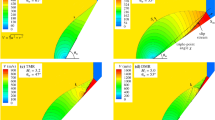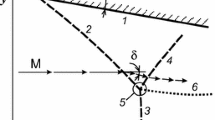Abstract
This experimental and numerical work reports on the dynamical behaviour of a shock in an inert gas at the concave wall of a hollow circular chamber. The gas in the chamber was air or He + \({\rm O}_{2}\) + 2 Ar at initial pressures \(p_{{\rm c0}}\) ranging from 2 to 12 kPa and initial temperature T0 =288 K. The shock was generated using a detonation driven shock tube. The shock dynamics were characterized through high-speed shadowgraph recordings and high-resolution numerical simulations. For each gas and \(p_\text {c0}\), the experiments evidenced the formation of a Mach reflection along the wall and identified a range of initial pressures for which this configuration rotates with constant stem heights and constant velocities larger than those at the chamber entry. The numerical simulations were capable of capturing the dynamics quantitatively. These results extend to inert gases our previous work with a reactive gas for which we reported on the possibility of a steadily rotating overdriven Mach detonation. The steadiness range is narrower with the inert gases, likely because of the smaller initial pressure ratios at the chamber entry and lower support from the subsonic flow behind the shock. The initial support in the reactive case was more efficient because the discontinuities at the chamber entry were self-sustained Chapman–Jouguet detonations. Further investigations of these Mach rotating regimes should rely only on specific experiments and numerical simulations, for example, on the effect of the chamber dimensions, because of the complex non-dimensional formulation of the problem.











Similar content being viewed by others
Availability of data and materials
The data that support the findings of this study are available from the corresponding author upon reasonable request.
References
Canteins G (2006) Etude de la détonation continue rotative: application à la propulsion (Thèse de doctorat). Université de Poitiers
Frolov SM, Aksenov VS, Ivanov VS, Shamshin IO (2015) Large-scale hydrogen-air continuous detonation combustor. Int J Hydrog Energy 40(3):1616–1623
Nicholls JA, Cullen RE, Ragland KW (1966) Feasibility studies of a rotating detonation wave rocket motor. J Spacecr Rockets 3(6):893–898
Wolanski P (2021) RDE research and development in Poland. Shock Waves 31:623–636
Tang X, Wang J, Shao Y (2015) Three-dimensional numerical investigations of the rotating detonation engine with a hollow combustor. Combust Flame 162(4):997–1008
Anand V, George ACS, Gutmark EJ (2016) Hollow rotating detonation combustor. In: Proceedings of the \(54^{th}\) AIAA Aerospace Sciences Meeting (Reston, Virginia), pp 1–15,
Bykovskii FA, Vedernikov EF (1996) Continuous detonation combustion of an annular gas-mixture layer. Combust Explos Shock Waves 32(5):489–491
Lin W, Zhou J, Liu S, Lin Z (2015) An experimental study on \(CH_4/O_2\) continuously rotating detonation wave in a hollow combustion chamber. Exp Therm Fluid Sci 62:122–130
Zhang H, Liu W, Liu S (2017) Experimental investigations on \(H_2/air\) rotating detonation wave in the hollow chamber with Laval nozzle. Int J Hydrog Energy 42(5):3363–3370
Hansmetzger S, Zitoun R, Vidal P (2018) A study of continuous rotation modes of detonation in an annular chamber with constant or increasing section. Shock Waves 28(5):1065–1078
Edwards DH, Fearnley P, Thomas GO, Nettleton MA (1981) Shocks and detonation in channels with \(90^{\circ }\) bends. In: Proceedings of the First Int. Specialist Meeting on Combustion (Talence, France), pp 431–435
Frolov SM, Aksenov VS, Shamshin IO (2007) Shock wave and detonation propagation through U-bend tubes. Proc Combust Inst 31(2):2421–2428
Kudo Y, Nagura J, Kasahara J, Sasamoto Y, Matsuo A (2011) Oblique detonation waves stabilized in rectangular-cross-section bent tubes. Proc Combust Inst 2(33):2319–2326
Nakayama H, Moriya T, Kasahara J, Matsuo A, Sasamoto Y, Funaki I (2012) Stable detonation wave propagation in rectangular-cross-section curved channel. Combust Flame 2(159):859–869
Nakayama H, Kasahara J, Matsuo A, Funaki I (2013) Front shock behavior of stable curved detonation waves in rectangular-cross-section curved channel. Proc Combust Inst 34(2):1936–1947
Sugiyama Y, Nakayama Y, Matsuo A, Nakayama H, Kasahara J (2014) Numerical investigations on detonation propagation in a two-dimensional curved channel. Combust Sci Technol 186(1):1662–1679
Short M, Quirk J, Meyer C, Chiquete C (2016) Steady detonation propagation in a circular arc: a detonation shock dynamics model. J Fluid Mech 807:87–134
Short M, Quirk J, Chiquete C, Meyer SD (2018) Detonation propagation in a circular arc: reactive burn modelling. J Fluid Mech 835:970–988
Short M, Chiquete C, Quirk J (2019) Propagation of a stable gaseous detonation in a circular arc configuration. Proc Combust Inst 37(3):3593–3600
Rodriguez V, Jourdain C, Vidal P, Zitoun R (2019) An experimental evidence of steadily-rotating overdriven detonation. Combust Flame 202(1):132–142
Melguizo-Gavilanes J, Rodriguez V, Vidal P, R Zitoun (2021) Dynamics of detonation transmission and propagation in a curved chamber: a numerical and experimental analysis. Combust Flame 223:460–473
Whitham G.B (1974) Linear and nonlinear waves. Wiley, New York
Jourdain C, Rodriguez V, Vidal P, Zitoun R (2019) Steadily-rotating overdriven detonation: comparison of experiments with geometrical shock dynamics modeling. AIAA Scitech 0200
Hornung H (1986) Regular and Mach reflection of shock waves. Annu Rev Fluid Mech 18(1):33–58
Ben-Dor G (1992) Shock wave reflection phenomena. Springer, New York
Burcat A, Ruscic B, et al (2005)Third millenium ideal gas and condensed phase thermochemical database for combustion (with update from active thermochemical tables). Technical report, Argonne National Lab.(ANL), Argonne, IL (United States)
Weller HG, Tabor G, Jasak H, Fureby C (1998) A tensorial approach to computational continuum mechanics using object-oriented techniques. Comput Phys 12:620–631
Kurganov A, Tadmor E (2000) New high-resolution central schemes for nonlinear conservation laws and convection-diffusion equations. J Comput Phys 160(1):241–282
Kurganov A, Noelle S, Petrova G (2001) Semidiscrete central-upwind schemes for hyperbolic conservation laws and Hamilton-Jacobi equations. SIAM J Sci Comput 23(3):707–740
Kraposhin M, Bovtrikova A, Strijhak S (2015) Adaptation of Kurganov-Tadmor numerical scheme for applying in combination with the PISO method in numerical simulation of flows in a wide range of Mach numbers. Proc Comput Sci 66:43–52
Gordon S, McBride B (1994) Computer program for calculation of complex chemical equilibrium compositions and applications, i. analysis, (ref. 1311), tech. rep. https://cearun.grc.nasa.gov/
Taylor GI (1950) The dynamics of the combustion products behind plane and spherical detonation fronts in explosives. Proc Roy Soc A 200:235–247
Acknowledgements
The authors would like to thank Alain Claverie, CNRS Research Engineer, for his technical assistance. The computations were carried out on the supercomputer facilities of the Mésocentre de Calcul de Poitou Charentes. This work was supported by the CPER-FEDER Project of Région Nouvelle Aquitaine and is part of the French government program Investissements d’Avenir (EUR INTREE ANR-18-EURE-0010).
Funding
Not applicable.
Author information
Authors and Affiliations
Contributions
All authors whose names appear on the submission. VR made substantial contributions to the conception or design of the work, the acquisition, analysis and, interpretation of data. JM drafted the work and revised it critically for important intellectual content. VM approved the version to be published; and PV agree to be accountable for all aspects of the work in ensuring that questions related to the accuracy or integrity of any part of the work are appropriately investigated and resolved.
Corresponding author
Ethics declarations
Conflict of interest
No competing interests.
Additional information
Publisher's Note
Springer Nature remains neutral with regard to jurisdictional claims in published maps and institutional affiliations.
Rights and permissions
Springer Nature or its licensor (e.g. a society or other partner) holds exclusive rights to this article under a publishing agreement with the author(s) or other rightsholder(s); author self-archiving of the accepted manuscript version of this article is solely governed by the terms of such publishing agreement and applicable law.
About this article
Cite this article
Rodriguez, V., Melguizo-Gavilanes, J., Monnier, V. et al. Steady rotation of a Mach shock: experimental and numerical evidences. Exp Fluids 64, 64 (2023). https://doi.org/10.1007/s00348-023-03612-z
Received:
Revised:
Accepted:
Published:
DOI: https://doi.org/10.1007/s00348-023-03612-z




